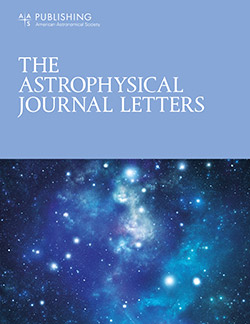JWST-TST梦想:WASP-17b大气中的石英云
IF 8.8
1区 物理与天体物理
Q1 ASTRONOMY & ASTROPHYSICS
引用次数: 0
摘要
迄今为止,在许多已观测到的系外行星大气中,云是普遍存在的。对于凌日系外行星,我们知道云是否存在,因为它们使光谱特征减弱,并引起波长相关的散射。虽然这些云的确切组成在很大程度上是未知的,但这些信息对于理解行星大气的化学和能量收支至关重要。在这项工作中,我们用JWST的中红外仪器低分辨率光谱仪观测了热木星WASP-17b的一次凌日,并产生了5到12 μ m的透射光谱,这些波长允许我们探测由于各种预测云种的振动模式而产生的吸收。我们的透射光谱显示了以8.6 μ m为中心的额外不透明度,详细的大气模拟和检索将此特征确定为sio2 (s)(石英)云。与无云模式相比,二氧化硅(s)云模式在3.5-4.2 σ时更可取,与一般气溶胶处方相比,在2.6 σ时更可取。我们发现二氧化硅(s)云由小的~ 0.01 μ m颗粒组成,这些颗粒延伸到大气中的高海拔地区。大气中也显示出h2o的消耗,这一发现与富氧物种形成高温气溶胶的情况一致。这项工作是我们的JWST望远镜科学家团队(JWST- tst)一系列研究的一部分,在这些研究中,我们将利用保证时间观测,通过多仪器光谱(DREAMS)对系外行星大气进行深度侦察。本文章由计算机程序翻译,如有差异,请以英文原文为准。
JWST-TST DREAMS: Quartz Clouds in the Atmosphere of WASP-17b
Abstract Clouds are prevalent in many of the exoplanet atmospheres that have been observed to date. For transiting exoplanets, we know if clouds are present because they mute spectral features and cause wavelength-dependent scattering. While the exact composition of these clouds is largely unknown, this information is vital to understanding the chemistry and energy budget of planetary atmospheres. In this work, we observe one transit of the hot Jupiter WASP-17b with JWST’s Mid-Infrared Instrument Low Resolution Spectrometer and generate a transmission spectrum from 5 to 12 μ m. These wavelengths allow us to probe absorption due to the vibrational modes of various predicted cloud species. Our transmission spectrum shows additional opacity centered at 8.6 μ m, and detailed atmospheric modeling and retrievals identify this feature as SiO 2 (s) (quartz) clouds. The SiO 2 (s) clouds model is preferred at 3.5–4.2 σ versus a cloud-free model and at 2.6 σ versus a generic aerosol prescription. We find the SiO 2 (s) clouds are composed of small ∼0.01 μ m particles, which extend to high altitudes in the atmosphere. The atmosphere also shows a depletion of H 2 O, a finding consistent with the formation of high-temperature aerosols from oxygen-rich species. This work is part of a series of studies by our JWST Telescope Scientist Team (JWST-TST), in which we will use Guaranteed Time Observations to perform Deep Reconnaissance of Exoplanet Atmospheres through Multi-instrument Spectroscopy (DREAMS).
求助全文
通过发布文献求助,成功后即可免费获取论文全文。
去求助
来源期刊

Astrophysical Journal Letters
ASTRONOMY & ASTROPHYSICS-
CiteScore
14.10
自引率
6.30%
发文量
513
审稿时长
2-3 weeks
期刊介绍:
The Astrophysical Journal Letters (ApJL) is widely regarded as the foremost journal for swiftly disseminating groundbreaking astronomical research. It focuses on concise reports that highlight pivotal advancements in the field of astrophysics. By prioritizing timeliness and the generation of immediate interest among researchers, ApJL showcases articles featuring novel discoveries and critical findings that have a profound effect on the scientific community. Moreover, ApJL ensures that published articles are comprehensive in their scope, presenting context that can be readily comprehensible to scientists who may not possess expertise in the specific disciplines covered.
 求助内容:
求助内容: 应助结果提醒方式:
应助结果提醒方式:


